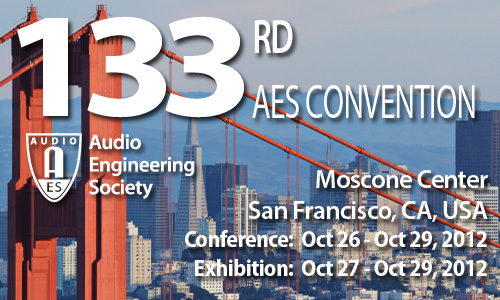
AES San Francisco 2012
Product Design Track Event EB2
Sunday, October 28, 4:00 pm — 5:45 pm (Room 122)
Engineering Brief: EB2 - eBrief Presentations—Lectures 1
Chair:
Lance Reichert, Sennheiser Electronic Corporation - San Francisco, CA, USA
EB2-1 A Comparison of Highly Configurable CPU- and GPU-Based Convolution Engines—Michael Schoeffler, International Audio Laboratories Erlangen - Erlangen, Germany; Wolfgang Hess, Fraunhofer Institute for Integrated Circuits IIS - Erlangen, Germany
In this work the performance of real-time audio signal processing convolution engines is evaluated. A CPU-based implementation using the Integrated Performance Primitives Library and two GPU-based implementations using
CUDA and OpenCL are compared. The purpose of these convolution engines is auralization, e.g., the binaural rendering of virtual multichannel configurations. Any multichannel input and output configuration is supported, e.g., 22.2 to 5.1, 7.1 to 2.0, vice versa, etc. This ability results in a trade-off between configurability and performance. Using a 5.1-to-binaural setup with continuous filter changes due to simulated head-tracking, GPU processing is more efficient when 24 filters of more than 1.92 seconds duration each @ 48 kHz sampling rate are convolved. The GPU is capable of convolving longer filters in real-time than a CPU-based processing. By comparing both GPU-based implementations, negligible performance differences between OpenCL and CUDA were measured.
Engineering Brief 60 (Download now)
EB2-2 Multichannel Audio Processor which Adapts to 2-D and 3-D Loudspeaker Setups—Christof Faller, Illusonic - Uster, Switzerland
A general audio format conversion concept is described for reproducing stereo and surround audio content on loudspeaker setups with any number of channels. The goal is to improve localization and to generate a recording-related spatial impression of depth and immersion. It is explained how with these goals signals
are processed using a strategy that is independent of a specific loudspeaker setup. The implementation of this general audio format conversion concept, in the Illusonic Immersive Audio Processor, is described.
Engineering Brief 61 (Download now)
EB2-3 A Comparison of Recording, Rendering, and Reproduction Techniques for Multichannel Spatial Audio—David Romblom, McGill University - Montreal, Quebec, Canada; Catherine Guastavino, McGill University - Montreal, Quebec, Canada; The Centre for Interdisciplinary Research in Music Media and Technology - Montreal, Quebec, Canada; Richard King, McGill University - Montreal, Quebec, Canada; The Centre for Interdisciplinary Research in Music Media and Technology - Montreal, Quebec, Canada
The objective of this project is to compare the relative merits of two different spatial audio recording and rendering techniques within the context of two different multichannel reproduction systems. The two recordings and rendering techniques are "natural," using main microphone arrays, and "virtual," using spot microphones, panning, and simulated acoustic delay. The two reproduction systems are the 3/2 system (5.1 surround), and a 12/2 system, where the frontal L/C/R triplet is replaced by a 12 loudspeaker linear array. Additionally, the project seeks to know if standard surround techniques can be used in combination with wavefront reconstruction techniques such as Wave Field Synthesis. The Hamasaki Square was used for the room effect in all cases, exhibiting the startling quality of increasing the depth of the frontal image.
Engineering Brief 62 (Download now)
EB2-4 The Reactive Source: A Reproduction Format Agnostic and Adaptive Spatial Audio Effect—Frank Melchior, BBC R&D - Salford, UK
Spatial audio has become a more and more active field of research and various systems are currently under investigation on different scales of effort and complexity. Given the potential of 3-D audio systems, spatial effects beyond source positioning and room simulation are desirable to enhance the creative flexibility. This paper describes a new adaptive spatial audio effect called reactive source. The reactive source uses low-level features of the incoming audio signal to dynamically adapt the spatial behavior of a sound source. Furthermore, the concept is format agnostic so that the effect could easily be applied to different 3-D audio reproduction methods using the same interaction method. To verify the basic concept, a prototype system for multichannel reproduction has been developed.
Engineering Brief 63 (Download now)
EB2-5 Teaching Critical Thinking in an Audio Production Curriculum—Jason Corey, University of Michigan - Ann Arbor, MI, USA
The practice of sound recording and production can be characterized as a series of decisions based primarily on subjective impressions of sound. These subjective impressions lead to equipment choices and use, not only for artistic effect but also to accomplish technical objectives. Nonetheless, the ability to think critically about recording techniques, equipment specifications, and sound quality is vitally important to equipment choice and use. The goal of this paper is to propose methods to encourage critical thinking among students in an audio production curriculum and to consider topics that might be included in coursework to help aspiring audio engineers evaluate audio equipment and processing.
Engineering Brief 64 (Download now)
EB2-6 Sync-AV – Workflow Tool for File-Based Video Shootings—Andreas Fitza, University of Applied Science Mainz - Mainz, Germany
The Sync-AV workflow eases the sorting and synchronization of video and audio footage without the needs of expensive special hardware. It supports the preproduction and the shooting as well as the post-production. It consists of three elements: A script-information- and metadata-gathering iOS app that is synchronized with a server-back-end. It can be used on different devices at once to exchange information onset. A server database with a web-front-end that can sort files by their metadata and show dailies as well. It can also be used to distribute and manage information during the preproduction. A local client that can synchronize and rename the files and that implements the metadata.
Engineering Brief 65 (Download now)
EB2-7 Audio over IP —Kieran Walsh, Audinate Pty. Ltd. - Ultimo, NSW, Australia
Developments in both IP networking and the attitude of professional audio to emerging technologies have presented the opportunity to consider a more abstract and all-encompassing approach to the ways that we manage data. We will examine this paradigm shift and discuss the benefits presented both in practical terms and creatively.
Engineering Brief 66 (Download now)
